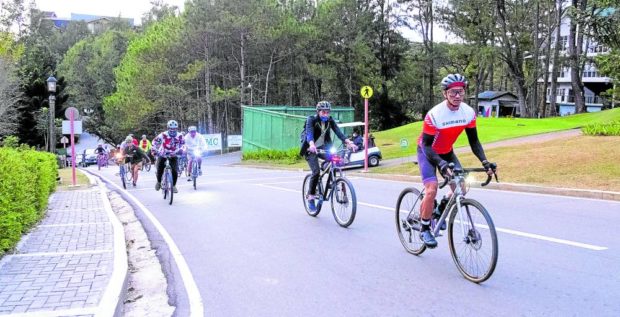
‘MICROMOBILITY’ | Almost 3,000 bikers commute or take leisurely rides through Baguio at any given day, and are now champions of a city government campaign to pursue “micromobility” or walking and biking to reduce traffic and pollution in the summer capital, as shown in this photo taken on Jan. 23, 2023. (Photo by NEIL CLARK ONGCHANGCO)
BAGUIO CITY, Benguet, Philippines — Commuting to work or school on bicycles may soon be integrated into the summer capital’s traffic system.
A proposed “Bicycle Code” being discussed at the City Council would set rules for employees, businessmen, traders and students who pedal through selected streets throughout the day.
But bikers should be required to get safety clearances that would be equivalent to a driver’s license after undergoing a mandatory safety seminar, said Councilor Betty Lourdes Tabanda during the council’s session on Jan. 23.
A complementary seminar must also be given to motorists to establish new road courtesy rules for bicycles sharing the streets, added Councilor Levi Lloyd Orcales.
The Baguio government has been advocating “micromobility” like walking or biking to reduce traffic jams and improve air quality in the mountain resort city.
According to the local biking community, 2,332 residents commute using bicycles, based on the city-backed bicycle count in 2022.
‘Shared roads’
Another key issue for bikers is whether school children would be allowed on the same streets during school days. The measure says only senior high school students aged 17 or 18 years old or college students of the same age or older may take bicycles through “shared roads” or a network of inner-city bicycle lanes.
Six “shared roads,” where bikers can travel safely to downtown Baguio alongside cars, were identified in 2021 by the city engineering office, but these bike routes may need further revisions due to updated street guidelines issued by the Department of Public Works and Highways, said Januario Borillo, who heads the Traffic and Transportation Management Division of the City Engineering Office.
The bikers also want access to Session Road, the city’s main commercial strip, where bicycles and motorcycles are prohibited.
Biker safety
The proposed ordinance establishes “first aid stations” along bicycle routes.
Joebel Gurang, a representative of the 2,900-man Daily Cycling Movement in Baguio, said they advocated for emergency stations for cyclists, given “evidence every year that cyclists get into accidents and [do not receive] quick first aide support while on the road.”
But lawyer Marissa Dacayanan, another bicycle enthusiast, suggested putting up hydration stations at designated bicycle lanes instead.
Most bikers (98.80 percent) were male, and the areas frequented by bikers were Magsaysay Avenue (which connects the university belt and the public market to Session Road), and the Panagbenga Park Rotunda which directs motorists towards Loakan Road (leading to Camp John Hay, the Philippine Military Academy, the Baguio City Economic Zone, and the Baguio Airport), to South Drive (leading to the Baguio Country Club), and upper Session Road.
Bikers also often take the road junction of Military Cut-Off (which leads to Panagbenga Park) and Kennon Road. This third route also brings travelers to three hospitals, including the Baguio General Hospital and Medical Center, as well as Marcos Highway for vehicles exiting the city.
Bicycle riders currently weave through congested Baguio streets, because of overcrowding and a high tourist influx.
An audit conducted by the city government projected the need for 22,000 parking spaces, given that 41,000 registered vehicles already use city streets, said Mayor Benjamin Magalong during a Jan. 25 briefing. The projection does not include the 450,000 to 480,000 vehicles driven by tourists at any given moment each year, he added.